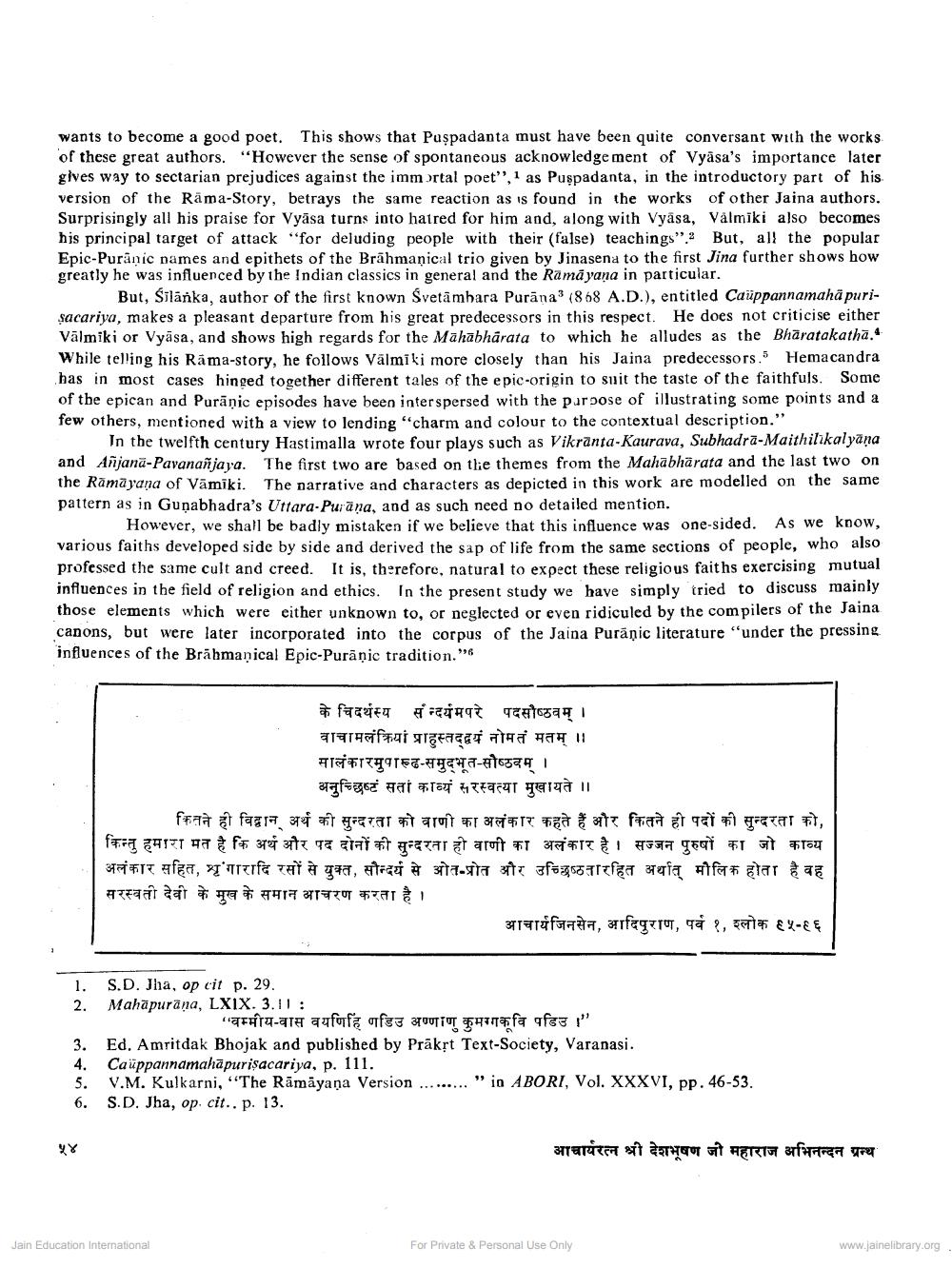Book Title: Ramayana of Valmiki and the Jain Puranas Author(s): Upendra Thakur Publisher: Z_Deshbhushanji_Maharaj_Abhinandan_Granth_012045.pdf View full book textPage 7
________________ wants to become a good poet. This shows that Puspadanta must have been quite conversant with the works of these great authors. "However the sense of spontaneous acknowledgement of Vyasa's importance later gives way to sectarian prejudices against the immortal poet", 1 as Puspadanta, in the introductory part of his version of the Rama-Story, betrays the same reaction as is found in the works of other Jaina authors. Surprisingly all his praise for Vyasa turns into hatred for him and, along with Vyasa, Valmiki also becomes his principal target of attack "for deluding people with their (false) teachings".2 But, all the popular Epic-Puranic pames and epithets of the Brahmanical trio given by Jinasena to the first Jina further shows how greatly he was influenced by the Indian classics in general and the Ramayana in particular. But, silarka, author of the first known Svetamhara Purana: (868 A.D.), entitled Cauppannamaha purisacariya, makes a pleasant departure from his great predecessors in this respect. He does not criticise either Valmiki or Vyasa, and shows high regards for the Mahabharata to which he alludes as the Bharatakatha. While telling his Rama-story, he follows Valmiki more closely than his Jaina predecessors.5 Hemacandra bas in most cases hinged together different tales of the epic-origin to suit the taste of the faithfuls. Some of the epican and Puranic episodes have been interspersed with the purpose of illustrating some points and a few others, mentioned with a view to lending "charm and colour to the contextual description." In the twelfth century Hastimalla wrote four plays such as Vikranta-Kaurava, Subhadra-Maithilikalyana and Anjana-Pavananjaya. The first two are based on the themes from the Mahabharata and the last two on the Ramayana of Vamiki. The parrative and characters as depicted in this work are modelled on the same pattern as in Gunabhadra's Uttara-Purana, and as such need no detailed mention. However, we shall be badly mistaken if we believe that this influence was one-sided. As we know, various faiths developed side by side and derived the sap of life from the same sections of people, who also professed the same cult and creed. It is, therefore, natural to expect these religious faiths exercising mutual influences in the field of religion and ethics. In the present study we have simply tried to discuss mainly those elements which were either unknown to, or neglected or even ridiculed by the compilers of the Jaina canons, but were later incorporated into the corpus of the Jaina Puranic literature "under the pressing. influences of the Brahmanical Epic-Puranic tradition." के चिदर्थस्य सन्दर्यमपरे पदसौष्ठवम् / वाचामलंक्रियां प्राहस्तदद्वयं नोमतं मतम् / / सालंकारमुपारुढ-समुदभूत-सौष्ठवम् / अनुच्छिष्टं सतां काव्यं सरस्वत्या मुखायते / / कितने ही विद्वान अर्थ की सुन्दरता को वाणी का अलंकार कहते हैं और कितने ही पदों की सुन्दरता को, किन्तु हमारा मत है कि अर्थ और पद दोनों की सुन्दरता ही वाणी का अलंकार है। सज्जन पुरुषों का जो काव्य अलंकार सहित, शृगारादि रसों से युक्त, सौन्दर्य से ओत-प्रोत और उच्छिष्ठतारहित अर्थात् मौलिक होता है वह सरस्वती देवी के मुख के समान आचरण करता है / आचार्यजिनसेन, आदिपुराण, पर्व 1, श्लोक 65-66 1. S.D. Jha, op cit p. 29. 2. Mahapurana, LXIX. 3.11 : w artaare aufufa ft3 TOUTTT 41119 fa qf63 /" 3. Ed. Amritdak Bhojak and published by Prakst Text-Society, Varanasi. 4. Cauppannamahapurisacariya, p. 111. 5. V.M. Kulkarni, "The Ramayana Version ......... " in ABORI, Vol. XXXVI, pp. 46-53. 6. S.D. Jha, op. cit., p. 13. आचार्यरत्न श्री देशभूषण जी महाराज अभिनन्दन ग्रन्थ Jain Education International For Private & Personal Use Only www.jainelibrary.org.Page Navigation
1 ... 5 6 7
